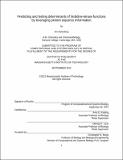Predicting and testing determinants of histidine-kinase functions by leveraging protein sequence information
Author(s)
Ashenberg, Orr
DownloadFull printable version (4.774Mb)
Other Contributors
Massachusetts Institute of Technology. Computational and Systems Biology Program.
Advisor
Amy E. Keating and Michael T. Laub.
Terms of use
Metadata
Show full item recordAbstract
All cells sense and respond to their environments using signal transduction pathways. These pathways control a sweeping variety of cellular processes across the domains of life, but the pathways are often built from a small, shared set of protein domains. At the core of tens of thousands of signal transduction networks in bacteria is a pair of proteins, a histidine kinase and a response regulator. Upon receiving an input signal, a histidine kinase autophosphorylates and then catalyzes transfer of its phosphoryl group to a cognate response regulator, which often activates a transcriptional response. Bacteria typically encode dozens of kinases and regulators, and the kinases function as dimers in all known examples. This dimeric state raises two functional questions. Do histidine kinases specifically form dimers? Once a kinase has dimerized, does a chain in the dimer phosphorylate itself (cis) or its partner chain (trans)? Specific kinase dimerization is likely important to avoid detrimental crosstalk between separate signaling pathways, and how autophosphorylation occurs is central to kinase activity. In my thesis, I have taken biochemical and evolutionary approaches to identify molecular determinants for both dimerization specificity and autophosphorylation. To study dimerization specificity, I developed an in vitro binding assay to measure kinase dimerization, and I then showed that a paralogous pair of kinases from E. coli specifically formed homodimers over heterodimers. Residues important for dimerization specificity were predicted by measuring amino acid coevolution within kinases, which leverages the enormous amount of sequence information available for the kinase family. Experimental verification of these predictions showed that a set of residues at the base of the kinase dimerization domain was sufficient to establish homospecificity. This same region of the kinase, in particular the loops at the base of the kinase dimer, was also important for determining autophosphorylation mechanism. Recent work showed that kinases could autophosphorylate either in cis or in trans, and I found that a trans kinase could be made to autophosphorylate in cis by replacing its loop with the loop from a cis kinase. I also found that two sets of orthologs, despite having significantly diverged loop sequences, had conserved their autophosphorylation mechanisms. This raised the possibility that kinase loops may be under selection to maintain the same autophosphorylation mechanism.
Description
Thesis (Ph. D.)--Massachusetts Institute of Technology, Computational and Systems Biology Program, February 2013. This electronic version was submitted by the student author. The certified thesis is available in the Institute Archives and Special Collections. Cataloged from student-submitted PDF version of thesis. "September 2012." Includes bibliographical references.
Date issued
2013Department
Massachusetts Institute of Technology. Computational and Systems Biology ProgramPublisher
Massachusetts Institute of Technology
Keywords
Computational and Systems Biology Program.